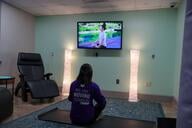You have /5 articles left.
Sign up for a free account or log in.
Katie Morris, a junior majoring in creative media at the University of Alabama, is having a hard time focusing on her studies. Fourteen months after contracting COVID-19, she still doesn’t feel like her old self and continues to experience symptoms of long COVID.
“I still can’t taste or smell after 14 months,” she said. “I also have been having trouble concentrating, and comprehension has been pretty bad. If I sit down and read 70 pages of a textbook, it kind of flies right over my head. I can’t pay attention to it. Fatigue has been a big one. Even just walking to class I’ll get tired.”
Morris said she approached the university’s Office of Disability Services at the beginning of the semester and just received approval for academic accommodations. She said the office asked for medical documentation, and it took her some time to get an appointment with a neurologist to document a diagnosis of long COVID.
“I was fully fine before,” Morris said. “I also wanted to point out that was a big thing even contacting ODS. Being a fully able person prior, even just to know that you can reach out and there is a place to reach out is a big thing.”
As an array of unexpected and in some cases quite serious side effects of the virus continue to show up in people who have recovered from COVID-19 infections, college disability services professionals are now spreading the word on long COVID symptoms and trying to build awareness of how colleges can support students like Morris who are experiencing long-term effects of COVID-19.
The Biden administration said in July that long COVID can qualify as a disability under federal disabilities law.
“It’s going to be a very challenging population for the disability services community to deal with, because it goes against what we usually do,” said Jane E. Jarrow, president of a consulting firm, Disability Access Information and Support, and facilitator of a 32-member task force on long COVID made up of disabilities services professionals in higher education.
Jarrow said that when students approach disability services offices seeking accommodations, one of the first steps in the process is to ask for verification of a disability. In this case, she said, “there’s every reason to believe” that some students who are suffering from long-haul COVID symptoms won’t even have documentation of a COVID diagnosis.
And for those who do, she said that documentation won’t necessarily “tell us anything about what they’re experiencing now. The symptomology is all over the block in terms of the functional limitations they’re experiencing at this point in time. The students don’t know what to ask for or in some cases even recognize that what they’re dealing with is a disability that can be addressed.”
The Mayo Clinic lists more than a dozen common symptoms of long COVID, defined as symptoms that persist more than four weeks after a COVID-19 diagnosis. Symptoms can include chest pain; cough; depression or anxiety; dizziness upon standing; fast or pounding heartbeat; fatigue; fever; headache; joint pain; loss of smell or taste; memory, concentration or sleep problems; muscle pain; shortness of breath or difficulty breathing; and worsened symptoms after physical or mental activities.
The long-COVID task force facilitated by Jarrow has published a workbook to help others in the field who are navigating this issue. The task force is currently revising the formatting of this document to make it fully accessible for individuals with disabilities using assistive technology. When completed, the accessible document will be available on the website of the Association on Higher Education and Disability (AHEAD).
The workbook includes detailed suggestions for questions disability services professionals can ask students during intake interviews to determine how COVID-19 has affected their lives, including their studies, and what accommodations, if any, may be appropriate. The workbook is not prescriptive and recognizes that colleges will differ in their approaches.
“How formal or informal you want documentation to be is going to be mirrored in how formal or informal you want documentation of ANY disability to be on your campus -- and we acknowledge that different institutions are all over the map in terms of what they are willing to accept,” the workbook says.
“The importance of self-disclosure will be the most pertinent during this time,” the workbook also says. “Some individuals are living with the residual effects of COVID without formally being diagnosed with COVID. Some individuals who are experiencing long COVID symptoms did not have a preexisting condition or disability and are struggling with a whole new aspect of their everyday life. These individuals may need the most assistance to understand how and why accommodations are utilized in a post-secondary setting.”
Possible accommodations listed in the workbook include extended time on tests, reduced-distraction testing, audio recording for classes, note-taking support, alternative text materials, priority scheduling and reduced course load.
“There are only so many accommodations we can make,” said Jarrow. “The disabilities services function essentially comes down to figuring out what the functional limitations are that are imposed by the disability and then finding ways to address those functional limitations through accommodations as necessary. The accommodations we’re going to make for students with long COVID aren’t necessarily different than those we make for kids with LDs [learning disabilities] or ADHD [attention deficit/hyperactivity disorder] or anxiety or depression.”
The workbook also discusses the potential that long COVID symptoms -- and the need for accommodations -- can change over time.
“Whether Long COVID is to be considered a disability or a temporary disability, it seems clear that the reported impact may shift over time and that there will need to be reevaluation to determine appropriate accommodations for current impact,” the workbook states.
It is not clear how many students have come forward yet with long COVID diagnoses. However, a number of professionals on the long-COVID task force interviewed for this article indicated they’d seen small numbers of students self-identify as having long COVID to date.
Sandra Harrison, executive director of the Office of Student Accessibility at Pepperdine University in California, said the first student to identify as having long COVID sought out her office in spring 2020, and the office has been supporting the student ever since, as that student’s needs have changed.
“And then we’ve had others who we didn’t meet until maybe this past summer, and we are supporting them in their journeys,” she said. “As long as people are still being diagnosed with COVID, this is on the horizon, and what we’ve noticed is it is affecting everybody uniquely.”
Cassie Kilroy Thompson, disability services coordinator for the University of Maryland, Baltimore County, said no students reporting long COVID have approached her office. But she said there has been an increase in the number of students with chronic health conditions and mental health conditions -- increases that she suspects are “at least partially related to long-term effects of COVID.”
Adam Meyer, director for Student Accessibility Services and Inclusive Education Services at the University of Central Florida, said just one student has come forward so far seeking accommodations due to long COVID.
“It’s new for us,” Meyer said. “So much of our field, we operate in this gray space. There’s not always a lot of very clear-cut black-and-white direction or answers or outcomes, and I think this is just going to continue to push some of our work into the gray. Assuming that our campuses in the next six to 12 months see an increase in students with long-haul COVID coming to our offices, each student is going to be different. The symptoms and the limitations they’re experiencing in a major life activity are going to be different.”
Terri Bassi-Cook, director of counseling and disability services at Seton Hill University in Pennsylvania, said she hopes the task force’s workbook helps to build awareness of long COVID across the university.
“Right now we need to inform the university community -- faculty, staff, everybody that may be a touch point for the students -- about what kinds of things that they would be hearing students say or behaviors that the students may be displaying and creating that lens of curiosity around, ‘could this possibly be COVID-related?’” Bassi-Cook said. “If we don’t have that lens developed, the number of students who find their way to either health services or disability services offices are going to be fewer than we would like it to be.”
Potentially complicating matters, Jacqueline M. Smith, director of the disabilities services office at Carlow University in Pennsylvania, said some students may be reluctant to attribute their symptoms to COVID “because it has become so divisive and so politicized. Depending on culture or family background, some students are more likely to deny that it’s relative to that.”
Sally Scott, director of research at AHEAD, described the workbook as “very timely and very practical … The really practical tools that are offered for what to consider in student interviews and documentation are the nuts and bolts of what disability resource professionals need to understand where students are encountering barriers and may need accommodations or supports.”
“I am reminded of many of the issues that came up in our research related to student mental health,” said Scott, who was not involved in the development of the workbook. “Similar to this quickly growing population, many students with long COVID will be new to the concept of disability. They may not consider themselves disabled or disabled enough to seek services; the disability is not visible to others, so they may encounter pushback about accommodation requests; they may not have any awareness of campus support services that are available. This has direct implications for disability resource professionals and requires additional outreach to students and campus colleagues to help get the word out.”




